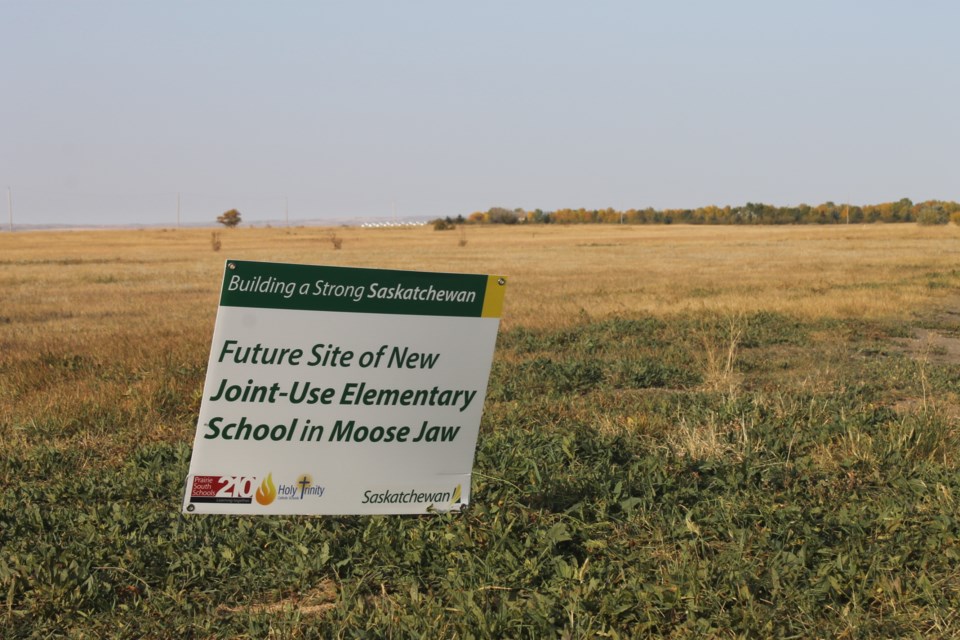A report that analyzed future traffic numbers near the proposed joint-use school in Westheath suggests the neighbourhood will see disruption at peak hours, but mitigation measures could lessen those problems.
Colliers Project Leaders drafted two preliminary sketch plans for phases 5 and 6 of the Westheath neighbourhood that include a new 10-acre joint elementary school. The plans were limited to two site configuration options — with both using Wellington Drive as the main roadway to access the school — based on the development’s size, the report explained.
The building would combine two schools each from Holy Trinity Roman Catholic School Division and Prairie South School Division.
Option A proposes a rectangular school site in the middle of the undeveloped area that would front Wellington Drive and have area streets and residential parcels surround the building, the report said. Two new north/south roads would provide access to future growth areas south of Westheath.
This concept maintains the closest relationship to the 2018 Westheath concept plan that the City of Moose Jaw developed for this subdivision, the report added.
Option B proposes a deeper, square-shaped school site along Wellington Drive that is situated more toward the eastern end of the development.
“This option was provided to show a different, possibly more preferred, school site configuration and its impact on lot yield,” added the report.
Local streets — which are narrower — and collector streets — which are wider — are the two main roads surrounding the proposed school site.
Wellington Drive is the main area collector roadway and can handle roughly 5,000 to 8,000 vehicles per day. Triton Street, William Avenue and Spadina Drive are some local area streets that can handle roughly 1,000 vehicles per day.
The typical peak periods for residents leaving and entering the Westheath neighbourhood are 7 to 9 a.m. and 4 to 6 p.m., the report explained. With Option A, it is estimated that daily trip generation would be 1,199 civilian vehicle trips, while daily trip generation under Option B would be 1,161 civilian vehicle trips.
“… the approved Westheath Concept Plan will generate more residential trips than the two proposed options,” continued the report.
In its report, Colliers Project Leaders reviewed potential vehicle trip generation when the school opens with 900 students and then later when the school reaches 1,100 students. The company also determined that peak hours would occur from 7 to 9 a.m. and 2 to 4 p.m.
With 900 students and 80 staff, the report projected there would be 281 inbound vehicle trips — school buses, staff, and parent drivers — and 201 outbound vehicle trips — parent drivers — in the morning. Those numbers would then be reversed in the afternoon. This would create 964 total daily vehicle trips generated near the school.
With 1,100 students and 100 staff, the report projected there would be 346 inbound vehicle trips and 246 outbound vehicle trips in the morning, with those numbers reversed in the afternoon. This would create 1,184 total daily trips.
“With a capacity of approximately 5,000 to 8,000 daily trips, it is anticipated that Wellington Drive would have enough design capacity to accommodate the trips generated by the school and residential development throughout the day,” the report said. “However, the addition of 482 vehicle trips during each of the (morning) and afternoon peak hours generated by the school will likely mean that some mitigation measures may be desirable.”
One mitigation measure could include encouraging traffic to circulate along Wellington Drive in a counter-clockwise direction to minimize left turns entering and exiting the school site, suggested the report. Other measures could include promoting more walking, bicycling and carpooling, and staggering school hours to minimize peak traffic flows arriving and departing.
The traffic impact assessment report is to be presented for acceptance at the Nov. 23 city council meeting. If approved, the project would then continue.




